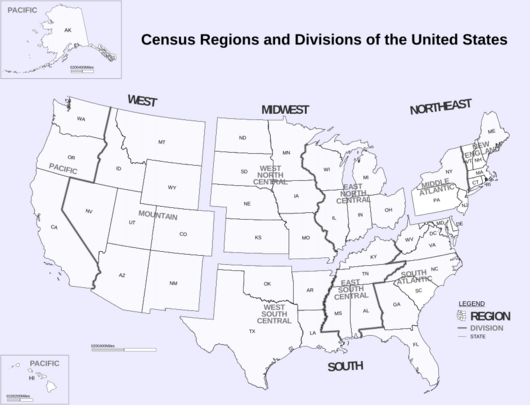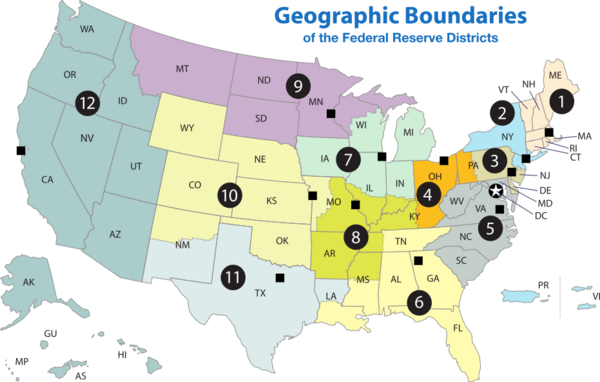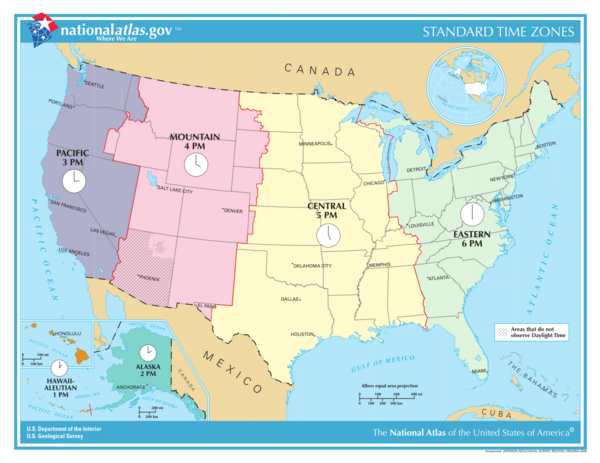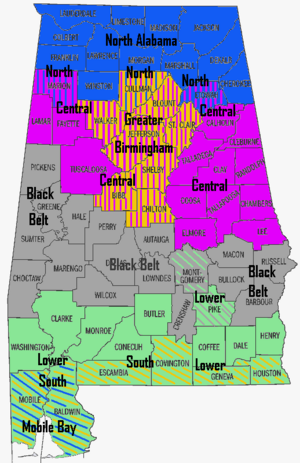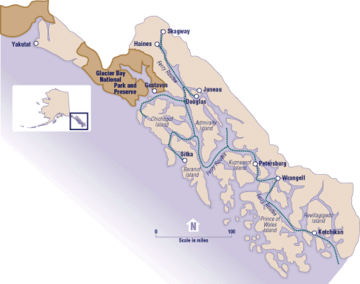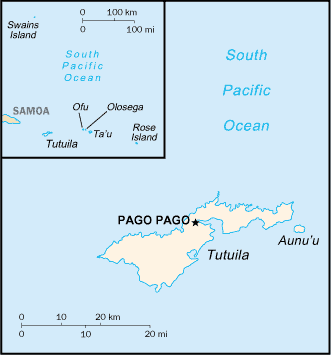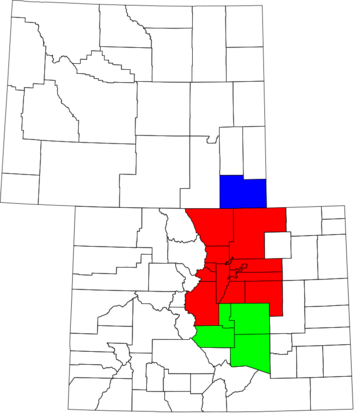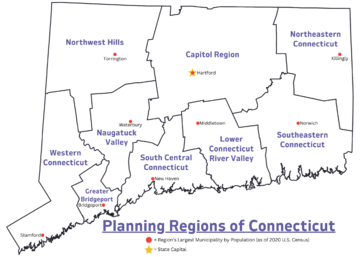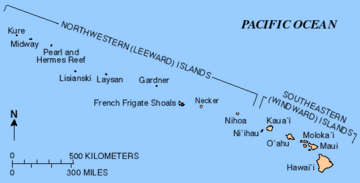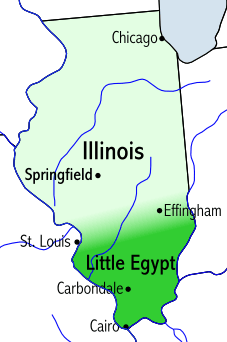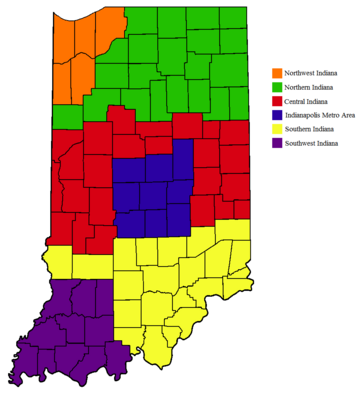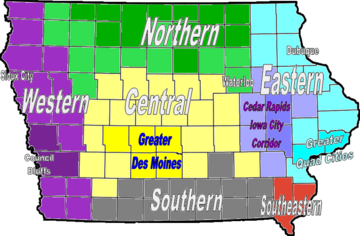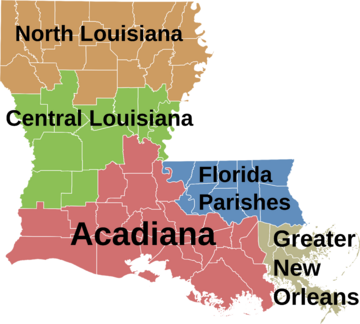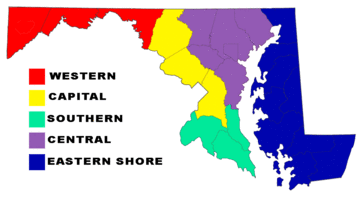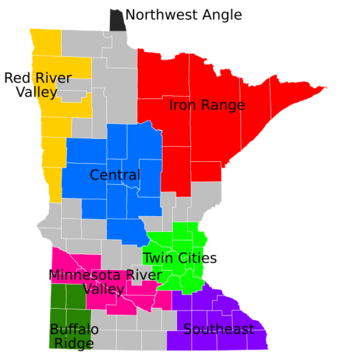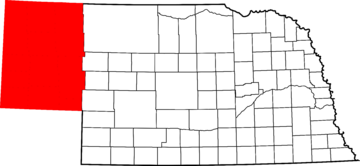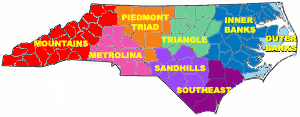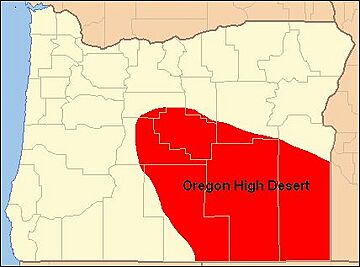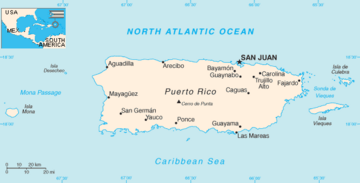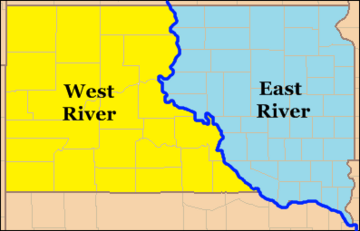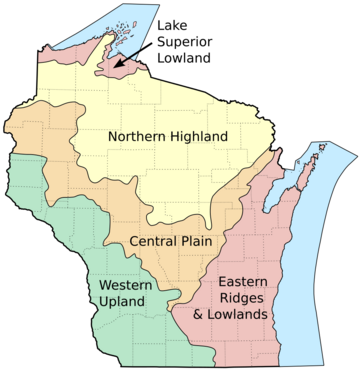List of regions of the United States facts for kids
This is a list of some of the ways regions are defined in the United States. Many regions are defined in law or regulations by the federal government; others by shared culture and history, and others by economic factors.
Contents
- Interstate regions
- Unofficial regions
- Intrastate and intraterritory regions
- Alabama
- Alaska
- American Samoa
- Arizona
- Arkansas
- California
- Colorado
- Connecticut
- Delaware
- District of Columbia
- Florida
- Georgia
- Guam
- Hawaii
- Idaho
- Illinois
- Indiana
- Iowa
- Kansas
- Kentucky
- Louisiana
- Maine
- Maryland
- Massachusetts
- Michigan
- Minnesota
- Mississippi
- Missouri
- Montana
- Nebraska
- Nevada
- New Hampshire
- New Jersey
- New Mexico
- New York
- North Carolina
- North Dakota
- Northern Mariana Islands
- Ohio
- Oklahoma
- Oregon
- Pennsylvania
- Puerto Rico
- Rhode Island
- South Carolina
- South Dakota
- Tennessee
- Texas
- U.S. Minor Outlying Islands
- U.S. Virgin Islands
- Utah
- Vermont
- Virginia
- Washington
- West Virginia
- Wisconsin
- Wyoming
- See also
Interstate regions
Census Bureau–designated regions and divisions
Since 1950, the United States Census Bureau defines four statistical regions, with nine divisions. The Census Bureau region definition is "widely used ... for data collection and analysis", and is the most commonly used classification system.
- Region 1: Northeast
- Division 1: New England (Connecticut, Maine, Massachusetts, New Hampshire, Rhode Island, and Vermont)
- Division 2: Middle Atlantic (New Jersey, New York, and Pennsylvania)
- Region 2: Midwest (designated as the North Central Region before June 1984)
- Division 3: East North Central (Illinois, Indiana, Michigan, Ohio, and Wisconsin)
- Division 4: West North Central (Iowa, Kansas, Minnesota, Missouri, Nebraska, North Dakota, and South Dakota)
- Region 3: South
- Division 5: South Atlantic (Delaware, Florida, Georgia, Maryland, North Carolina, South Carolina, Virginia, Washington, D.C., and West Virginia)
- Division 6: East South Central (Alabama, Kentucky, Mississippi, and Tennessee)
- Division 7: West South Central (Arkansas, Louisiana, Oklahoma, and Texas)
- Region 4: West
- Division 8: Mountain (Arizona, Colorado, Idaho, Montana, Nevada, New Mexico, Utah, and Wyoming)
- Division 9: Pacific (Alaska, California, Hawaii, Oregon, and Washington)
Puerto Rico and other US territories are not part of any census region or census division.
Federal Reserve Banks
The Federal Reserve Act of 1913 divided the country into twelve districts with a central Federal Reserve Bank in each district. These twelve Federal Reserve Banks together form a major part of the Federal Reserve System, the central banking system of the United States. Missouri is the only U.S. state to have two Federal Reserve locations within its borders, but several other states are also divided between more than one district.
- Boston
- New York
- Philadelphia
- Cleveland
- Richmond
- Atlanta
- Chicago
- St. Louis
- Minneapolis
- Kansas City
- Dallas
- San Francisco
Time zones
- UTC−12:00 (Baker Island, Howland Island)
- Samoa Time Zone (American Samoa, Jarvis Island, Kingman Reef, Midway Atoll, Palmyra Atoll)
- Hawaii–Aleutian Time Zone (Hawaii, Aleutian Islands (Alaska), Johnston Atoll)
- Alaska Time Zone (Alaska, excluding Aleutian Islands)
- Pacific Time Zone
- Arizona Time Zone (excluding the Navajo Nation)
- Mountain Time Zone (excluding most parts of Arizona)
- Central Time Zone
- Eastern Time Zone
- Atlantic Time Zone (Puerto Rico, U.S. Virgin Islands)
- Chamorro Time Zone (Guam, Northern Mariana Islands)
- Wake Island Time Zone (Wake Island)
Courts of Appeals circuits
- First Circuit
- Second Circuit
- Third Circuit
- Fourth Circuit
- Fifth Circuit
- Sixth Circuit
- Seventh Circuit
- Eighth Circuit
- Ninth Circuit
- Tenth Circuit
- Eleventh Circuit
- D.C. Circuit
The Federal Circuit is not a regional circuit. Its jurisdiction is nationwide but based on the subject matter.
Agency administrative regions
In 1969, the Office of Management and Budget published a list of ten "Standard Federal Regions", to which Federal agencies could be restructured as a means of standardizing government administration nationwide. Despite a finding in 1977 that this restructuring did not reduce administrative costs as initially expected, and the complete rescinding of the standard region system in 1995, several agencies continue to follow the system, including the Environmental Protection Agency and the Department of Housing and Urban Development.
Regions and office locations
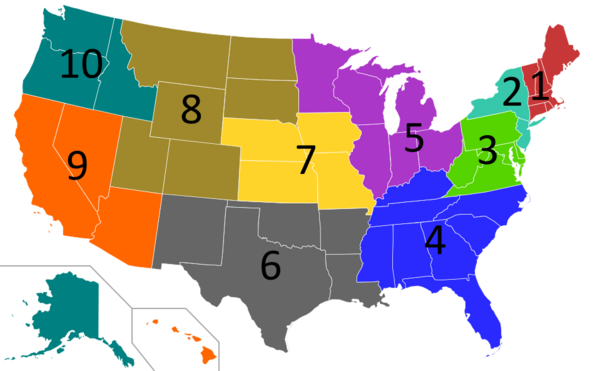
Region I
Office location: Boston
States: Connecticut, Maine, Massachusetts, New Hampshire, Rhode Island, and Vermont
Region II
Office location: New York City
States: New York, New Jersey, Puerto Rico, and the Virgin Islands
Region III
Office location: Philadelphia
States: Delaware, District of Columbia, Maryland, Pennsylvania, Virginia, and West Virginia
Region IV
Office location: Atlanta
States: Alabama, Florida, Georgia, Kentucky, Mississippi, North Carolina, South Carolina, and Tennessee
Region V
Office location: Chicago
States: Illinois, Indiana, Minnesota, Michigan, Ohio, and Wisconsin
Region VI
Office location: Dallas
States: Arkansas, Louisiana, New Mexico, Oklahoma, and Texas
Region VII
Office location: Kansas City
States: Iowa, Kansas, Missouri, and Nebraska
Region VIII
Office location: Denver
States: Colorado, Montana, North Dakota, South Dakota, Utah, and Wyoming
Region IX
Office location: San Francisco
States: Arizona, California, Hawaii, Nevada, Guam, and American Samoa
Region X
Office location: Seattle
States: Alaska, Idaho, Oregon, and Washington
Unofficial regions
Multi-state regions
- American Frontier
- Appalachia
- Ark-La-Tex
- Black Dirt Region
- Border states:
- The Californias
- Calumet Region
- The Carolinas
- Cascadia
- Central United States
- Coastal states
- Colorado Plateau
- Columbia Basin
- Contiguous United States
- The Dakotas
- Deep South
- Delmarva Peninsula
- Dixie
- Dixie Alley
- Driftless Area
- East Coast
- Eastern United States
- Four Corners
- Great American Desert
- Great Appalachian Valley
- Great Basin
- Great Lakes Region
- Great Plains
- Gulf Coast
- High Plains
- Interior Plains
- Intermountain States
- Kentuckiana
- Llano Estacado
- Lower 48
- Michiana
- Mid-Atlantic states
- Mid-South states
- Midwestern United States
- Mississippi Delta
- Mojave Desert
- Mormon Corridor
- New England
- North Woods
- Northeastern United States
- Northern United States
- Northwestern United States
- Ohio Valley
- Ozarks
- Pacific Northwest
- Inland Northwest
- Palouse
- Piedmont
- Piney Woods
- Rocky Mountains
- Siouxland
- Southeastern United States
- Southern United States
- Old South
- Southwestern United States
- Old Southwest
- Tidewater
- Tornado Alley
- Trans-Mississippi
- Twin Tiers
- Upland South
- Upper Midwest
- Virginias
- Waxhaws
- West Coast
- Western United States
Multi-territory regions
- Mariana Islands (Guam and the Northern Mariana Islands)
- Samoan Islands (American Samoa, except Swains Island)
- Virgin Islands (the Spanish Virgin Islands and the U.S. Virgin Islands)
The Belts
- Bible Belt
- Black Belt
- Coal Belt
- Corn Belt
- Cotton Belt
- Fruit Belt
- Pine Belt
- Rice Belt
- Rust Belt
- Snowbelt
- Sun Belt
Interstate megalopolises
- Further information: Megalopolis
- Arizona Sun Corridor
- California
- Cascadia
- Great Lakes
- Gulf Coast
- Northeast
- Piedmont Atlantic
- Southern Rocky Mountain Front
Interstate metropolitan areas
- Central Savannah River Area (part of Georgia and South Carolina)
- Baltimore–Washington metropolitan area (District of Columbia and parts of Maryland, Virginia, West Virginia, and Pennsylvania)
- Washington metropolitan area (District of Columbia and parts of Maryland, Virginia, and West Virginia)
- Greater Boston (parts of Massachusetts, Rhode Island, and New Hampshire)
- Charlotte metropolitan area (parts of North Carolina and South Carolina)
- Chattanooga Metropolitan Area
- Chicago metropolitan area (parts of Illinois, Indiana, and Wisconsin)
- Cincinnati metropolitan area (parts of Ohio, Indiana, and Kentucky)
- Columbus-Auburn-Opelika (GA-AL) Combined Statistical Area (parts of Georgia and Alabama)
- Delaware Valley (Philadelphia metropolitan area) (parts of Pennsylvania, New Jersey, Delaware, and Maryland)
- Evansville, IN–KY Metropolitan Statistical Area (parts of Indiana and Kentucky)
- Fargo–Moorhead (parts of North Dakota and Minnesota)
- Fort Smith metropolitan area (parts of Arkansas and Oklahoma)
- Front Range Urban Corridor (parts of Colorado and Wyoming)
- Greater Grand Forks (part of Minnesota and North Dakota)
- Hartford-Springfield (parts of Connecticut and Massachusetts)
- Kansas City metropolitan area (parts of Missouri and Kansas)
- Louisville metropolitan area (Kentuckiana) (parts of Kentucky and Indiana)
- Memphis metropolitan area (parts of Tennessee, Arkansas, and Mississippi)
- Michiana (parts of Michigan and Indiana)
- Minneapolis–Saint Paul (the Twin Cities) (parts of Minnesota and Wisconsin)
- New York metropolitan area (parts of New York, New Jersey, Connecticut, and Pennsylvania)
- Omaha–Council Bluffs metropolitan area (parts of Nebraska and Iowa)
- Portland metropolitan area (parts of Oregon and Washington)
- Quad Cities (parts of Iowa and Illinois)
- Sacramento metropolitan area (parts of California and Nevada)
- Greater St. Louis (parts of Missouri and Illinois)
- Texarkana metropolitan area (parts of Texas and Arkansas)
- Tri-Cities (parts of Tennessee and Virginia)
- Twin Ports (Duluth, Minnesota and Superior, Wisconsin)
- Hampton Roads region (parts of Virginia and North Carolina)
- Youngstown–Warren–Boardman metropolitan statistical area (parts of Ohio and Pennsylvania)
Intrastate and intraterritory regions
Alabama
- Alabama Gulf Coast
- Greater Birmingham
- Black Belt
- Central Alabama
- Lower Alabama
- Mobile Bay
- North Alabama
- Northeast Alabama
- Northwest Alabama
- South Alabama
Alaska
- Alaska Interior
- Alaska North Slope
- Alaska Panhandle
- Aleutian Islands
- Arctic Alaska
- The Bush
- Kenai Peninsula
- Matanuska-Susitna Valley
- Seward Peninsula
- Southcentral Alaska
- Southwest Alaska
- Tanana Valley
- Yukon-Kuskokwim Delta
American Samoa
- Manu'a Islands
- Rose Atoll
- Swains Island
- Tutuila and Aunu'u
Arizona
- Arizona Strip
- Grand Canyon
- North Central Arizona
- Northeast Arizona
- Northern Arizona
- Phoenix metropolitan area
- Southern Arizona
Arkansas
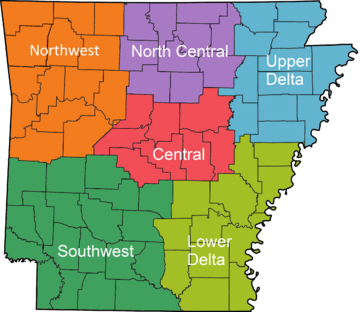
- Arkansas Delta
- Arkansas River Valley
- Arkansas Timberlands
- Central Arkansas
- Crowley's Ridge
- Northwest Arkansas
- South Arkansas
California
Colorado
- Central Colorado (part of Southern Rocky Mountains)
- Colorado Eastern Plains (part of High Plains)
- Colorado Mineral Belt (part of Southern Rocky Mountains)
- Colorado Piedmont (parts of the Front Range Urban Corridor and Colorado High Plains)
- Colorado Plateau (multi-state region)
- Colorado Western Slope (parts of Southern Rocky Mountains and Colorado Plateau)
- Denver Metropolitan Area (part of Front Range Urban Corridor)
- Four Corners Region (multi-state region of Colorado Plateau)
- Front Range Urban Corridor (multi-state region)
- High Plains (multi-state region of Great Plains)
- North Central Colorado Urban Area (part of Front Range Urban Corridor)
- Northwestern Colorado (part of Southern Rocky Mountains)
- San Luis Valley
- South-Central Colorado
- South Central Colorado Urban Area (part of Front Range Urban Corridor)
- Southern Rocky Mountains (multi-state region of Rocky Mountains)
- Southwestern Colorado (parts of Southern Rocky Mountains and Colorado Plateau)
Connecticut
Connecticut has 9 official planning regions. These regions operate as councils of governments, and are recognized as county equivalents by the U.S. Census Bureau.
- Capitol Region
- Greater Bridgeport
- Lower Connecticut River Valley
- Naugatuck Valley
- Northeastern Connecticut
- Northwest Hills
- South Central Connecticut
- Southeastern Connecticut
- Western Connecticut
Some of Connecticut's informal regions include:
- Coastal Connecticut
- Connecticut panhandle/Gold Coast
- Farmington Valley
- Housatonic Valley
- Litchfield Hills
- Quiet Corner
Delaware

"Upstate" or "Up North"
- Delaware Valley, also known as "Above the Canal" (referring to the Chesapeake and Delaware Canal)
"Slower Lower"
- Cape Region
- Central Kent
- Delaware coast
District of Columbia
Florida
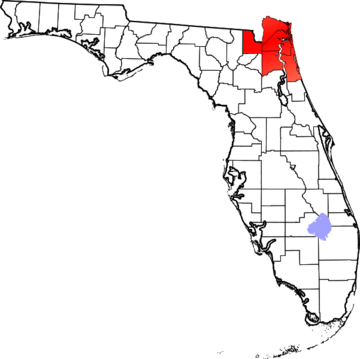
Directional regions
- Central Florida
- North Florida
- Northwest Florida
- North Central Florida
- Northeast Florida
- South Florida
- Southwest Florida
- West Florida
- East Florida
Local vernacular regions
- Big Bend
- Emerald Coast
- First Coast
- Florida Heartland
- Florida Keys
- Florida Panhandle
- Forgotten Coast
- Glades
- Gold Coast
- Halifax area (also Surf Coast and Fun Coast)
- Red Hills
- Nature Coast
- Space Coast
- Suncoast
- Tampa Bay Area
- Treasure Coast
Georgia
- Atlanta metropolitan area
- Central Georgia
- Central Savannah River Area
- Colonial Coast
- Golden Isles of Georgia
- North Georgia
- North Georgia mountains (Northeast Georgia)
- Southern Rivers
- Southeast Georgia
- Wiregrass Region
Physiographic regions
Guam
- Cocos Island
- Guam (main island)
- Ritidian Point
- Tumon
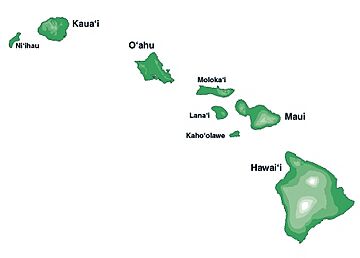
Hawaii
- Hawaiʻi Island (Big Island)
- Hamakua Coast
- Kaʻū Desert
- Kohala Coast
- Kona Coast
- Mauna Kea
- Puna District
- Waiākea-Uka
- Kahoʻolawe
- Kauaʻi
- Kaʻula
- Lānai
- Maui
- Molokaʻi
- Niʻihau
- Northwestern Hawaiian Islands
- Oʻahu
- Kaʻena Point
- Makapuʻu
- North Shore
- Waikīkī
Idaho
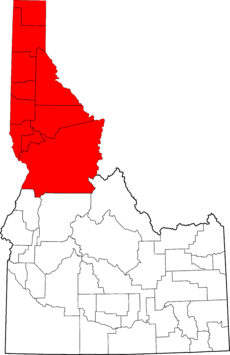
- Central Idaho
- Eastern Idaho
- Idaho Panhandle
- Magic Valley
- North Central Idaho
- Palouse Hills
- Southern Idaho
- Southwestern Idaho
- Treasure Valley
Illinois
- Central Illinois
- Champaign–Urbana metropolitan area
- Chicago metropolitan area
- Community areas in Chicago
- Fox Valley
- The Collar Counties
- North Shore
- Driftless Area
- Forgottonia
- Metro-East
- American Bottom
- River Bend
- Metro Lakeland
- Military Tract of 1812
- Northern Illinois
- Northwestern Illinois
- Peoria, Illinois metropolitan area
- Quad Cities
- Rock River Valley
- Shawnee Hills
- Southern Illinois (sometimes, Little Egypt)
- Tri-State Area
- Wabash Valley
Indiana
- East Central Indiana
- Indianapolis metropolitan area
- Michiana
- Northern Indiana
- Northwest Indiana
- Southern Indiana
- Southwestern Indiana
- Wabash Valley
Iowa
- Coteau des Prairies
- Des Moines metropolitan area
- Dissected Till Plains
- Driftless Area
- Great River Road
- Honey Lands
- Iowa Great Lakes
- Loess Hills
- Omaha–Council Bluffs metropolitan area
- Quad Cities
- Siouxland
Kansas
- East-Central Kansas
- Flint Hills
- High Plains
- Kansas City Metropolitan Area
- North Central Kansas
- Osage Plains
- Ozarks
- Red Hills
- Santa Fe Trail
- Smoky Hills
- Southeast Kansas
Kentucky
- The Bluegrass
- Cumberland Plateau or Eastern Coal Field
- Jackson Purchase
- Pennyroyal Plateau
- Western Coal Field
Louisiana
-
- Cajun Heartland
- River Parishes
- Central Louisiana (Cen-La)
- Florida Parishes
- "French Louisiana" (Acadiana + Greater New Orleans)
- Greater New Orleans
- North Louisiana
- Southwest Louisiana
Maine
- Acadia
- Down East
- High Peaks / Maine Highlands
- Hundred-Mile Wilderness
- Kennebec Valley
- Maine Highlands
- Maine Lake Country
- Maine North Woods
- Mid Coast
- Penobscot Bay
- Southern Maine Coast
- Western Maine Mountains
Maryland
- Baltimore–Washington Metropolitan Area
- Capital region
- Chesapeake Bay
- Eastern Shore of Maryland
- Patapsco Valley
- Southern Maryland
- Western Maryland
Regions shared with other states:
- Allegheny Mountains
- Atlantic coastal plain
- Blue Ridge Mountains
- Cumberland Valley
- Delaware Valley
- Delmarva Peninsula consists of Maryland's and Virginia's Eastern Shore and all of Delaware
- Piedmont (United States)
- Ridge-and-Valley Appalachians
Massachusetts
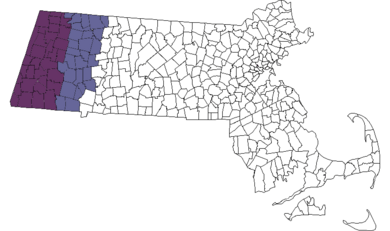
- Western Massachusetts
- The Berkshires (shown in map)
- Housatonic Valley
- Pioneer Valley
- Quabbin-Swift River Valley
- Central Massachusetts
- Northeastern Massachusetts
- Southeastern Massachusetts
Michigan
Lower Peninsula
- Northern Michigan
- Traverse Bay Area
- Straits Area
- Central/Mid-Michigan
- The Thumb
- Bluewater Area
- Tri-Cities
- Capital Region
- West Michigan
- Southwest Michigan
- Michiana
- Grand Rapids area
- Southeast Michigan
Upper Peninsula
- Western Upper Peninsula
- Copper Country
- Central Upper Peninsula
- US 41 Corridor
- Eastern Upper Peninsula
Minnesota
- Arrowhead Region
- Boundary Waters
- Buffalo Ridge
- Central Minnesota
- Coulee Region
- Iron Range
- Minnesota River Valley
- North Shore
- Northwest Angle
- Pipestone Region
- Red River Valley
- Southeast Minnesota
- Twin Cities Metro
Mississippi
Missouri
- Boonslick
- Bootheel
- Dissected Till Plains
- Kansas City Metropolitan Area
- Lead Belt
- Little Dixie
- Ozarks
- Platte Purchase
- St. Louis Metropolitan Area
Montana
- Big Horn Mountains
- Eastern Montana
- The Flathead
- Glacier Country
- Glacier National Park
- Regional designations of Montana
- Two Medicine
- Western Montana
- Yellowstone National Park
Nebraska
- Nebraska Panhandle
- Pine Ridge
- Rainwater Basin
- Sand Hills
- Wildcat Hills
Nevada
New Hampshire
- Connecticut River Valley
- Dartmouth-Lake Sunapee Region (overlaps with Connecticut River Valley)
- Great North Woods Region
- Lakes Region
- Merrimack Valley
- Monadnock Region (overlaps with Connecticut River Valley)
- Seacoast Region
- White Mountains
New Jersey
- North Jersey
- Skylands
- Amwell Valley
- Black Dirt Region (shared with New York)
- Great Valley
- Hunterdon Plateau
- Ridge-and-Valley Appalachians
- Highlands
- Somerset Hills
- The Sourlands
- Gateway
- Skylands
- Central Jersey
- Bayshore
- Jersey Shore
- Shore Region
- South Jersey
- Shore Region
- New Jersey Pine Barrens
- Delaware Valley
- Southern Shore
New Mexico
- Central New Mexico
- Eastern New Mexico
- New Mexico Bootheel
- Northern New Mexico
New York
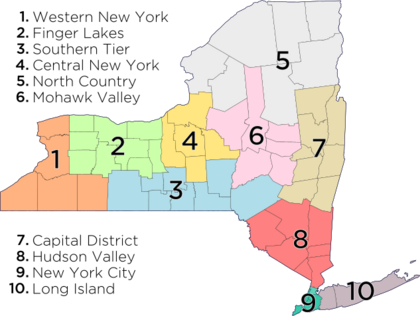
1. Western New York – counties: Niagara, Erie, Chautauqua, Cattaraugus, Allegany
2. Finger Lakes – counties: Orleans, Genesee, Wyoming, Monroe, Livingston, Wayne, Ontario, Yates, Seneca
3. Southern Tier – counties: Steuben, Schuyler, Chemung, Tompkins, Tioga, Chenango, Broome, Delaware
4. Central New York – counties: Cortland, Cayuga, Onondaga, Oswego, Madison
5. North Country – counties : St. Lawrence, Lewis, Jefferson, Hamilton, Essex, Clinton, Franklin
6. Mohawk Valley – counties: Oneida, Herkimer, Fulton, Montgomery, Otsego, Schoharie
7. Capital District – counties : Albany, Columbia, Greene, Warren, Washington, Saratoga, Schenectady, Rensselaer
8. Hudson Valley – counties: Sullivan, Ulster, Dutchess, Orange, Putnam, Rockland, Westchester
9. New York City – counties (boroughs): New York (Manhattan), Bronx (The Bronx), Queens (Queens), Kings (Brooklyn), Richmond (Staten Island)
10. Long Island – counties: Nassau, Suffolk
- Downstate New York
- New York metropolitan area (New York City)
- Long Island
- East End
- The Hamptons
- North Shore (Gold Coast)
- South Shore
- Upstate New York
- Erie Canal Corridor
- Western New York
- Finger Lakes
- former Leatherstocking Country (now the Central New York Region)
- Central New York
- Central New York Military Tract
- Phelps and Gorham Purchase
- Syracuse metropolitan area
- Mohawk Valley
- Southern Tier
- Capital District
- North Country
- Adirondack Mountains
- Ski country
- Thousand Islands
- Tug Hill
- Catskill Mountains
- Borscht Belt
- Hudson Valley
- Shawangunk Ridge
- Black Dirt Region (shared with New Jersey)
North Carolina
- Western North Carolina
- Foothills Region
- South Mountains
- The Unifour (Catawba Valley Area)
- High Country (Boone Area)
- Land of the Sky
- Foothills Region
- Central North Carolina
- Piedmont Crescent
- Metropolitan Charlotte (Metrolina)
- Metropolitan Piedmont Triad
- Sauratown Mountains
- Uwharrie Mountains
- Yadkin Valley
- The Research Triangle
- New Hope Valley
- Piedmont Crescent
- Eastern North Carolina
- Fayetteville Metropolitan Area
- Inner Banks
- Lower Cape Fear (Wilmington Area)
- Outer Banks
- Sandhills
North Dakota
- Badlands
- Drift Prairie
- Missouri Escarpment
- Missouri Plateau (Missouri Coteau in French)
- Red River Valley
Northern Mariana Islands
Ohio
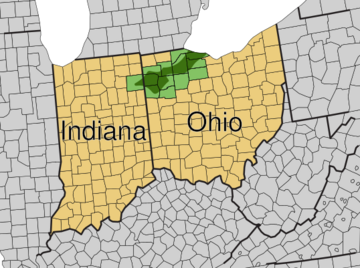
- Allegheny Plateau
- Appalachian Ohio
- Cincinnati-Northern Kentucky metropolitan area
- Columbus, Ohio metropolitan area
- Connecticut Western Reserve (historic, now defunct)
- Great Black Swamp (shared with Indiana)
- The Lake Erie Islands
- Miami Valley
- Northeast Ohio (often used interchangeably with Greater Cleveland, but also includes the counties of Ashtabula, Portage, Summit, Trumbull, Mahoning and Columbiana.)
- Northwest Ohio
Oklahoma
- Central Oklahoma
- Cherokee Outlet
- Green Country
- Choctaw Country
- Little Dixie
- Northwestern Oklahoma
- Panhandle
- South Central Oklahoma
- Southwestern Oklahoma
Oregon
- Cascade Range
- Central Oregon
- Columbia Plateau
- Columbia River
- Columbia River Gorge
- Eastern Oregon
- Goose Lake Valley
- Harney Basin
- High Desert
- Hood River Valley
- Mount Hood Corridor
- Northwest Oregon
- Oregon Coast
- Palouse
- Portland metropolitan area
- Rogue Valley
- Southern Oregon
- Treasure Valley
- Tualatin Valley
- Warner Valley
- Western Oregon
- Willamette Valley
Pennsylvania
- Allegheny National Forest
- Coal Region
- Cumberland Valley
- Delaware Valley
- Dutch Country
- Endless Mountains
- Highlands Region
- Laurel Highlands
- Lehigh Valley
- Northern Tier
- Northeastern Pennsylvania
- Philadelphia Main Line
- Pittsburgh metropolitan area
- South Central Pennsylvania
- Susquehanna Valley
- The Poconos
- Western Pennsylvania
- Wyoming Valley
Puerto Rico
Rhode Island
South Carolina
- The Lowcountry
- The Midlands
- The Upstate
- Travel/Tourism locations
- Grand Strand
- Lake Murray Country
- The Lowcountry & Resort Islands
- Old 96 District
- Olde English District
- Pee Dee
- Santee Cooper Country
- Other geographical distinctions
- Blue Ridge Mountains
- Charleston metropolitan area
- Columbia metropolitan area
- The Piedmont
- The Sandhills
- Sea Islands
- West Ashley
South Dakota
- East River and West River, divided by the Missouri River
- Badlands
- Black Hills
- Coteau des Prairies
Tennessee
- East Tennessee
- Middle Tennessee
- West Tennessee
- Other geographical distinctions:
Texas
- Brazos Valley
- Central Texas
- Texas blackland prairies
- The Hill Country
- Gulf Coast
- East Texas
- Piney Woods and Northeast Texas
- North Texas
- Dallas–Fort Worth Metroplex
- Texoma
- South Texas
- Southeast Texas
- Golden Triangle
- Greater Houston
- Texas Midwest/West-Central Texas (includes Abilene, San Angelo, Brownwood, Texas)
- Texas Urban Triangle (Houston to San Antonio to Dallas-Fort Worth)
- West Texas
- Concho Valley
- Edwards Plateau
- Llano Estacado (a portion of northwest Texas)
- Permian Basin
- South Plains (includes 24 counties south of the Texas Panhandle and north of the Permian Basin)
- Texas Panhandle (pictured)
- Trans-Pecos
- Great Plains
U.S. Minor Outlying Islands
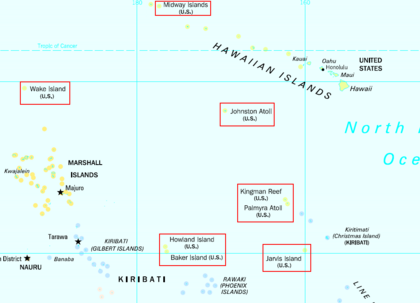
- Baker Island
- Howland Island
- Jarvis Island
- Johnston Island
- Kingman Reef
- Midway Atoll
- Navassa Island
- Palmyra Atoll
- Wake Island
U.S. Virgin Islands
Utah
- Cache Valley
- Colorado Plateau
- Dixie
- Great Salt Lake Desert
- Mojave Desert
- San Rafael Swell
- Uinta Mountains
- Wasatch Back
- Wasatch Front
- Wasatch Range
Vermont
- Burlington metropolitan area
- Champlain Valley
- Green Mountains
- Mount Mansfield
- Northeast Kingdom
Virginia
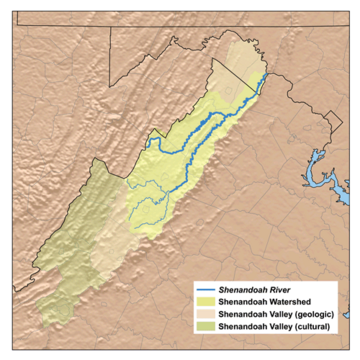
- Eastern Shore
- Hampton Roads
- Historic Triangle
- Piedmont region of Virginia
- Northern Neck
- Northern Virginia
- Greater Richmond Region
- Shenandoah Valley
- South Hampton Roads
- Southside Virginia
- Southwest Virginia
- Tidewater
- Tri-Cities
- Virginia Peninsula
Washington
- Central Washington
- Columbia Plateau
- Eastern Washington
- Kitsap Peninsula
- Long Beach Peninsula
- Okanagan Country
- Olympic Mountains
- Olympic Peninsula
- Puget Sound
- San Juan Islands
- Skagit Valley
- Southwest Washington
- Tri-Cities
- Walla Walla Valley
- Western Washington
- Yakima Valley
West Virginia
- Eastern Panhandle
- North Central West Virginia
- Northern Panhandle
- Potomac Highlands
- Southern West Virginia
Wisconsin
Wisconsin can be divided into five geographic regions.
- Central Plain
- Eastern Ridges and Lowlands
- Lake Superior Lowland
- Northern Highland
- Western Upland
Wyoming
See also
 In Spanish: Regiones de Estados Unidos para niños
In Spanish: Regiones de Estados Unidos para niños
- Geography of the United States
- Historic regions of the United States
- List of metropolitan areas of the United States
- Media market, e.g., Nielsen Designated Market Area
- Political divisions of the United States
- Regional stock exchanges of the United States
- United States territory
- Vernacular geography


